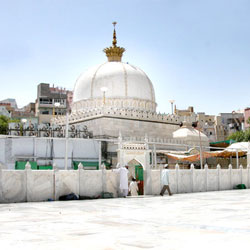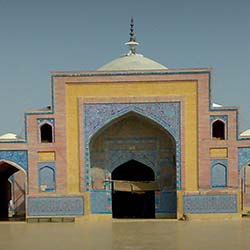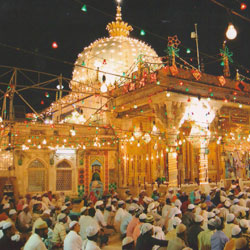
- Home
- Travel Packages
- Top Destination
-
Travel Attraction
By Category
Top Attraction

- Travel Agents
- Car Rentals
- Hotels

Khwaja Moinuddin Chistis Dargah
About The Khwaja Moinuddin Chistis Dargah The Khwaja Moinuddin Chishti Dargah is one of the most revered Sufi shrines in India, located in the city of Ajmer, Rajasthan. It is the final resting place of the Sufi saint Khwaja Moinuddin Chishti, who is also known as Gharib Nawaz, meaning "Benefactor of the Poor". The Dargah is visited by millions of pilgrims every year, regardless of their religion, to seek blessings and fulfill their wishes. Architecture of Khwaja Moinuddin Chistis Dargah The architecture of the Khwaja Moinuddin Chishti Dargah is a beautiful blend of Mughal and Rajput styles. The main entrance, known as the Nizam Gate, leads to a courtyard with the tomb of the saint in the center. The tomb is made of marble and is adorned with intricate carvings and precious stones. The Dargah also has a mosque, a large courtyard for prayers, and a separate section for women. History The Khwaja Moinuddin Chishti Dargah was built in the 13th century by Sultan Iltutmish of Delhi. Khwaja Moinuddin Chishti was a Sufi saint who traveled to India from Persia and settled in Ajmer. He was known for his teachings of peace, love, and unity among all religions. The Dargah has since become a symbol of harmony and spirituality for people of all faiths. Best Time To Visit The best time to visit the Khwaja Moinuddin Chishti Dargah is during the annual Urs festival, which commemorates the death anniversary of the saint. The Urs festival takes place in the Islamic month of Rajab and attracts pilgrims from across the country. The Dargah is also crowded during other Islamic festivals like Eid and Ramadan. How To Reach The Khwaja Moinuddin Chishti Dargah is located in the heart of Ajmer city, making it easily accessible by road, rail, and air. The nearest airport is in Jaipur, which is around 135 km away. Ajmer also has a well-connected railway station, with trains from major cities like Delhi, Mumbai, and Jaipur. Local buses and taxis are available for transportation within the city. Visitor Tips 1. Dress modestly and respectfully when visiting the Dargah, covering your head and removing your shoes before entering the shrine. 2. Photography is not allowed inside the Dargah premises, so be mindful of this restriction. 3. Make sure to respect the customs and traditions of the Dargah, such as offering prayers and tying threads on the marble screens. 4. Be cautious of touts and beggars outside the Dargah who may try to exploit your generosity. 5. Visit early in the morning or late in the evening to avoid the crowds and experience the peaceful atmosphere of the Dargah.
Explore More
About The Shah Jahan's Mosque The Shah Jahan's Mosque, located in Ajmer, Rajasthan, is a beautiful architectural marvel built by Mughal emperor Shah Jahan in the 17th century. This mosque holds significant historical and cultural importance in India and is a popular tourist attraction for visitors from all over the world. Architecture of Shah Jahan's Mosque The Shah Jahan's Mosque boasts stunning Mughal architecture with intricate carvings and delicate designs. The mosque features white marble domes, finely crafted minarets, and elegant archways that showcase the grandeur of Mughal craftsmanship. The main prayer hall is adorned with exquisite floral patterns and calligraphy, creating a serene and spiritual atmosphere for worshippers. History The Shah Jahan's Mosque was commissioned by Emperor Shah Jahan in 1638 during his visit to Ajmer. It was constructed in honor of his beloved wife, Mumtaz Mahal, who is buried nearby in the famous Ajmer Sharif Dargah. The mosque stands as a symbol of the Mughal Empire's architectural legacy and their influence on Indian culture and society. Best Time To Visit The best time to visit the Shah Jahan's Mosque is during the cooler months of October to March when the weather is pleasant and ideal for exploring the historical sites in Ajmer. Avoid visiting during the summer months as the temperature can soar, making it uncomfortable for sightseeing. How To Reach The Shah Jahan's Mosque is easily accessible by road, rail, and air. The nearest railway station is Ajmer Junction, which is well-connected to major cities in India. The mosque is also conveniently located near the Ajmer Bus Stand, making it accessible by public transportation. If traveling by air, the nearest airport is Jaipur International Airport, which is approximately 135 kilometers away from Ajmer. Visitor Tips 1. Respect the religious significance of the mosque and dress modestly when visiting. 2. Remove your shoes before entering the mosque to show respect for the sacred space. 3. Take time to admire the intricate details of the architecture and immerse yourself in the historical ambiance of the mosque. 4. Visit during prayer times to experience the spiritual atmosphere and witness the local community in worship. 5. Hire a guide to learn more about the history and significance of the Shah Jahan's Mosque for a more enriching experience.
Explore More
About The Khwaja Garib Nawaz Dargah The Khwaja Garib Nawaz Dargah, located in Ajmer, Rajasthan, is one of the most important Sufi shrines in India. It is dedicated to Khwaja Moinuddin Chishti, a 13th-century Sufi saint who is also known as Garib Nawaz, which means "benefactor of the poor." The Dargah is a place of pilgrimage for Muslims from all over the world, as well as people of other faiths who come to seek blessings and offer prayers. Architecture of Khwaja Garib Nawaz Dargah The Dargah complex is built in a traditional Mughal architectural style, with white marble buildings adorned with intricate carvings and beautiful domes. The centerpiece of the complex is the tomb of Khwaja Moinuddin Chishti, which is surrounded by a large courtyard where devotees gather to offer prayers and seek blessings. The Dargah also houses several other tombs, mosques, and other structures that date back to different periods in history. History The Khwaja Garib Nawaz Dargah was built in the 13th century after the death of Khwaja Moinuddin Chishti. He was a revered Sufi saint who dedicated his life to helping the poor and promoting peace and harmony among people of different faiths. His teachings and spiritual presence attracted a large following, and after his death, the Dargah was established as a place of pilgrimage for his devotees. Over the centuries, the Dargah has become a symbol of unity and brotherhood, attracting people from all walks of life. Best Time To Visit The best time to visit the Khwaja Garib Nawaz Dargah is during the annual Urs festival, which commemorates the death anniversary of Khwaja Moinuddin Chishti. The festival is held in the seventh month of the Islamic lunar calendar and lasts for six days, attracting millions of pilgrims from around the world. The Dargah is beautifully decorated with lights and flowers during this time, and the atmosphere is filled with devotion and spiritual fervor. How To Reach The Khwaja Garib Nawaz Dargah is located in the heart of Ajmer city, making it easily accessible by road, rail, and air. The nearest airport is in Jaipur, which is about 130 kilometers away from Ajmer. The Ajmer Junction railway station is well-connected to major cities in India, making it convenient for visitors to reach the Dargah by train. Additionally, there are regular bus services from nearby cities to Ajmer, making it easy for pilgrims to travel to the Dargah. Visitor Tips When visiting the Khwaja Garib Nawaz Dargah, it is important to dress modestly and show respect for the religious customs and traditions of the place. Visitors are required to remove their shoes before entering the Dargah complex and maintain a peaceful and reverent demeanor. It is also customary to offer prayers and make a donation at the shrine as a sign of reverence and gratitude. Additionally, travelers should be prepared for large crowds, especially during the Urs festival, and plan their visit accordingly to make the most of their spiritual experience at the Dargah. Overall, the Khwaja Garib Nawaz Dargah is not just a religious site but also a symbol of peace, unity, and brotherhood that welcomes people of all faiths with open arms. Whether you are a devout Muslim seeking blessings or a curious traveler interested in exploring the rich spiritual heritage of India, a visit to this sacred shrine is sure to leave a lasting impression on your heart and soul.
Explore MoreRajasthan Jaipur(2N), Bikaner(1N), Jaisalmer(2N), Jodhpur(1N), Udaipur(2N) Package
9 Days/ 8 Night
Jaipur - Bikaner - Jaisalmer - Jodhpur - Udaipur
Royal Rajasthan Tour - 7 Days
7 Days/ 6 Night
Bikaner - Jaipur - Jaisalmer - Jodhpur
3D - 2N Jaipur Tour Package
3 Days/ 2 Night
Jaipur
The Golden Triangle - 5 Nights 6 Days
6 Days/ 5 Night
Agra - Jaipur - New Delhi